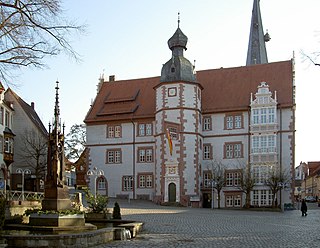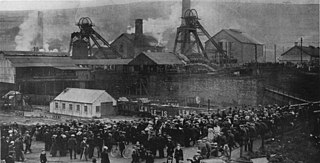Peine is a district in Lower Saxony, Germany. It is bounded by the districts of Hildesheim, Hanover and Gifhorn, and the cities of Brunswick and Salzgitter.

Alfeld is a town in the state of Lower Saxony, Germany. Located on the Leine river, it is the second biggest city in the district of Hildesheim in southern Lower Saxony and part of the Metropolitan region Hannover-Braunschweig-Göttingen-Wolfsburg. Alfeld is a member of the Leinebergland region and on the German Timber-Frame Road. With the Fagus Factory, Alfeld became a UNESCO World Heritage Site in 2011.

On 7 November 1963, 11 West German miners were rescued from a collapsed mine after surviving for 14 days, an event that later became known as the Wunder von Lengede.
A mining accident is an accident that occurs during the process of mining minerals or metals. Thousands of miners die from mining accidents each year, especially from underground coal mining, although accidents also occur in hard rock mining. Coal mining is considered much more hazardous than hard rock mining due to flat-lying rock strata, generally incompetent rock, the presence of methane gas, and coal dust. Most of the deaths these days occur in developing countries, and rural parts of developed countries where safety measures are not practiced as fully.

Lake Peigneur is a brackish lake in the U.S. state of Louisiana, 1.2 miles north of Delcambre and 9.1 mi (14.6 km) west of New Iberia, near the northernmost tip of Vermilion Bay. With a maximum depth of 200 feet, it is the deepest lake in Louisiana. Its name comes from the French word "peigneur", meaning "one who combs."

The Quecreek Mine rescue took place in Somerset County, Pennsylvania, when nine miners were trapped underground for over 77 hours, from July 24 to 28, 2002. All nine miners were rescued.

The Senghenydd colliery disaster, also known as the Senghenydd explosion, occurred at the Universal Colliery in Senghenydd, near Caerphilly, Glamorgan, Wales, on 14 October 1913. The explosion, which killed 439 miners and a rescuer, is the worst mining accident in the United Kingdom. Universal Colliery, on the South Wales Coalfield, extracted steam coal, which was much in demand. Some of the region's coal seams contained high quantities of firedamp, a highly explosive gas consisting of methane and hydrogen.

The Oaks Colliery explosion was a British mining disaster which occurred on 12 December 1866, killing 361 miners and rescuers at the Oaks Colliery at Hoyle Mill near Stairfoot in Barnsley, West Riding of Yorkshire. The disaster centred upon a series of explosions caused by firedamp, which ripped through the underground workings. It is the worst mining accident in England and the second worst mining disaster in the United Kingdom, after the Senghenydd colliery disaster in Wales.

The Beaconsfield gold mine collapsed on 25 April 2006 in Beaconsfield, Tasmania, Australia. Of the seventeen people who were in the mine at the time, fourteen escaped immediately following the collapse, one was killed and the remaining two were found alive on the sixth day by miners Pat Ball and Steve Saltmarsh. These two miners were rescued on 9 May 2006, two weeks after being trapped nearly 1 kilometre (0.62 mi) below the surface.

The Gresford disaster occurred on 22 September 1934 at Gresford Colliery, near Wrexham, in northeast Wales, when an explosion and underground fire killed 266 men. Gresford is one of Britain's worst coal mining disasters: a controversial inquiry into the disaster did not conclusively identify a cause, though evidence suggested that failures in safety procedures and poor mine management were contributory factors. Further public controversy was caused by the decision to permanently seal the colliery's damaged districts, meaning that only eleven of those who died were recovered.
The Crandall Canyon Mine, formerly Genwal Mine, was an underground bituminous coal mine in northwestern Emery County, Utah.

The Knockshinnoch disaster was a mining accident that occurred in September 1950 in the village of New Cumnock, Ayrshire, Scotland. A glaciated lake filled with liquid peat and moss flooded pit workings, trapping more than a hundred miners underground. For several days rescue teams worked non-stop to reach the trapped men. Most were eventually rescued three days later, but 13 died. The disaster was an international media event.

The 2010 Copiapó mining accident, also known then as the "Chilean mining accident", began on Thursday, 5 August 2010, with a cave-in at the San José copper–gold mine, located in the Atacama Desert 45 kilometers (28 mi) north of the regional capital of Copiapó, in northern Chile. Thirty-three men, trapped 700 meters (2,300 ft) underground and 5 kilometers (3 mi) from the mine's entrance via spiraling underground ramps, were rescued after 69 days.

A Dahlbusch Bomb is an emergency evacuation device for use in mining. In its original form it is a torpedo-shaped cylinder with a length of 2.5 metres, developed to transport trapped miners through boreholes after mining accidents. It does not contain explosive: it was called a "bomb" because of its shape.

The 2010 Copiapó mining accident occurred when the San Jose Mine near to Copiapó, Chile, collapsed, leaving 33 miners of Chilean nationality and one Bolivian miner trapped inside about 700 metres below the surface. The men were trapped in the mine for 69 days before being rescued. The discovery of the miners and their eventual rescue received global attention, with over 2000 members of the media reporting from the San Jose Mine. Global leaders expressed good wishes for the rescue and congratulations upon its successful completion.
The 2010 Copiapó mining accident began as a cave-in on 5 August 2010 at the San José copper-gold mine in the Atacama Desert near Copiapó, Chile. The accident trapped 33 men 700 meters (2,300 ft) underground who survived for a record 69 days. All were rescued and brought to the surface on 13 October 2010 over a period of almost 24 hours. After the last trapped miner was winched to the surface, the rescue workers still underground held up a sign before the camera stating "Misión cumplida Chile" to the estimated more than 1 billion people watching the rescue on live television around the world.
The 2010 Copiapó mining accident began as a cave-in on 5 August 2010 at the San José copper-gold mine in the Atacama Desert near Copiapó, Chile. The accident left 33 men trapped 700 meters (2,300 ft) below ground who survived underground for a record 69 days. All 33 men were rescued and brought to the surface on 13 October 2010 over a period of almost 24 hours. After the last trapped miner was winched to the surface, the rescue workers still underground held up a sign before the camera stating "Misión cumplida Chile" to the estimated more than 1 billion people watching the rescue on live television around the world.
The 2010 Copiapó mining accident began as a cave-in on 5 August 2010 at the San José copper-gold mine in the Atacama Desert near Copiapó, Chile. The accident left 33 men trapped 700 meters (2,300 ft) below ground who survived underground for a record 69 days. All 33 men were rescued and brought to the surface on 13 October 2010 over a period of almost 24 hours. After the last trapped miner was winched to the surface, the rescue workers still underground held up a sign before the camera stating "Misión cumplida Chile" to the estimated more than 1 billion people watching the rescue on live television around the world.
The mining disaster at Lassing occurred the morning of 17 July 1998. The accident in the Upper Styrian municipality of Lassing was the worst of its kind in Austria since 1945.

The Great Snaefell Mine, also referred to as the East Snaefell Mine, was a zinc mine located high in the Laxey Valley on the slopes of Snaefell Mountain, in the parish of Lonan, Isle of Man. The mine reached a depth of 1,188 ft (362 m) and is remembered as the scene of the Isle of Man's worst mining disaster in 1897.
















